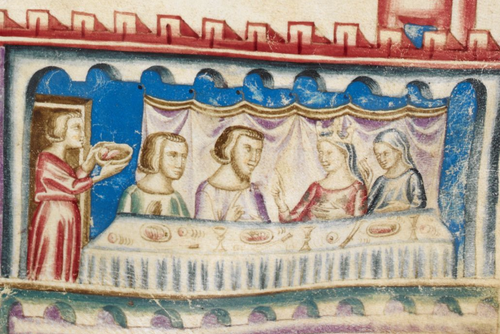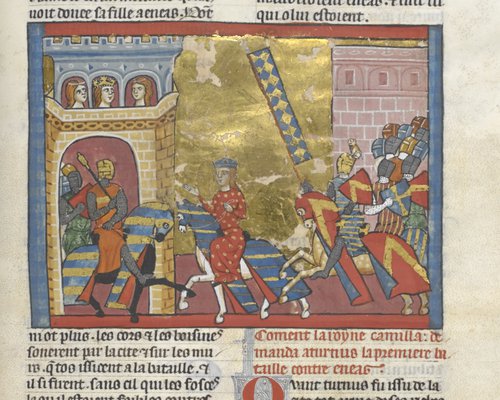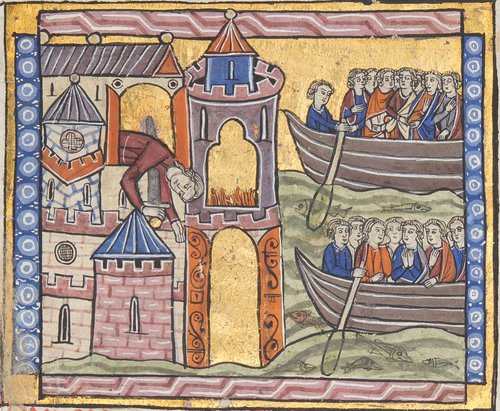Eneas arrives
We are delighted to publish online the first iteration of the first segment of our editions of the Histoire ancienne jusqu’à César: the Eneas section of the version in BnF, f. fr. 20125. This aspect of our work is led by Hannah Morcos, but all members of the TVOF team have collaborated in the production of this edition. You can access our interpretive text on this page: Histoire ancienne jusqu’à César.
The edition we are publishing now is not in its final form. We have taken the decision to share work in progress online, partly to give scholars interested in the hitherto unedited portions of the Histoire ancienne access to the texts as soon as it is possible to make them available, and partly in the hope that users will give us feedback enabling us to correct any errors and improve any aspects of the online editions whether these be substantive, presentational, or functional.
Users may consult in parallel, if they wish, two versions of the text: a semi-diplomatic transcription and an interpretive edition of the manuscript. Please note: this is not a critical edition of the text, but an edition of the text in a specific manuscript. At the moment, the notes are not extensive: currently different types of notes, which appear in a popup window, are cued by different icons and they are limited to identifying sources, to textual difficulties and key divergent readings of other MSS, with only the occasional more interpretive note.

Eneas and Dido feasting. London, British Library, Royal 20 D I, f. 197r. Reproduced with the permission of the British Library Board.
However, over the next six months or so we will be adding and testing with users considerable further functionality, which will entail also improvements to the viewer and enhanced navigation tools: dynamic searches of both versions of the text, lemmatization of the text enabling research on both lexis and morphology (with links to the DEAF), and a select glossary. In due course, we will be adding an index of proper names and it will also be possible to download a PDF of any of the material. As we add new functionality, we will at every stage welcome feedback.

Camilla going into battle against Eneas. London, British Library, Royal 20 D I, f. 197r. Reproduced with the permission of the British Library Board.
One key aspect of the edited text on which we would welcome your views already is the use of diacritics. At present we have decided to keep these to a bare minimum. Acute accents are used as prescribed by the guidelines of the Ecole des Chartes. However, we have provisionally limited the use of tremas to the disambiguation of homographs that occur in the part of the text that we have edited (e.g. oir ‘heir’ and oïr ‘to hear’ (and all inflections of oïr); pais ‘peace’ and païs ‘country’). This is a preliminary approach and will be developed after lemmatising the text. The current version of the text will be updated to reflect our eventual conventions. We welcome, however, feedback on this issue.
We have punctuated our interpretive edition lightly, often taking our cues from (but without following) the medieval punctuation. Users will be able to see the medieval punctuation in our semi-diplomatic transcription.
We will in due course publish materials for the linguistic analysis of BnF, f. fr. 20125. These materials will have a particular focus on the implications of fr. 20125’s segmentation of the text for our understanding its syntax, style and narrative sign-posting.
The referencing system of the edition is keyed to the paragraphs of BnF, f. fr. 20125, which we have numbered sequentially throughout the 375 folios of the manuscript. This referencing system is the basis of a collation of select manuscripts which is well under way. Again we hope to make the results of this research available online progressively.
Later this year, we will publish the corresponding section from London, British Library, Royal 20 D I and again parallel viewing will be possible. Watch this space.
If you have any comments or feedback on any aspect of our work in progress on these editions, please fill in the form at the bottom of this page. If your comment relates to a specific section of the text, please include the paragraph and segment number (e.g. §588.1).
You might like to know that apart from our philological labours, the TVOF team has devoted considerable critical discussion to the version of the Eneas story in the Histoire ancienne: our considered opinion is that you can't trust Eneas further than you can throw him, particularly if you are a woman.
Thank you!

Dido committing suicide. Paris, BnF, f. fr. 20125, f. 156v (source: gallica.bnf.fr).